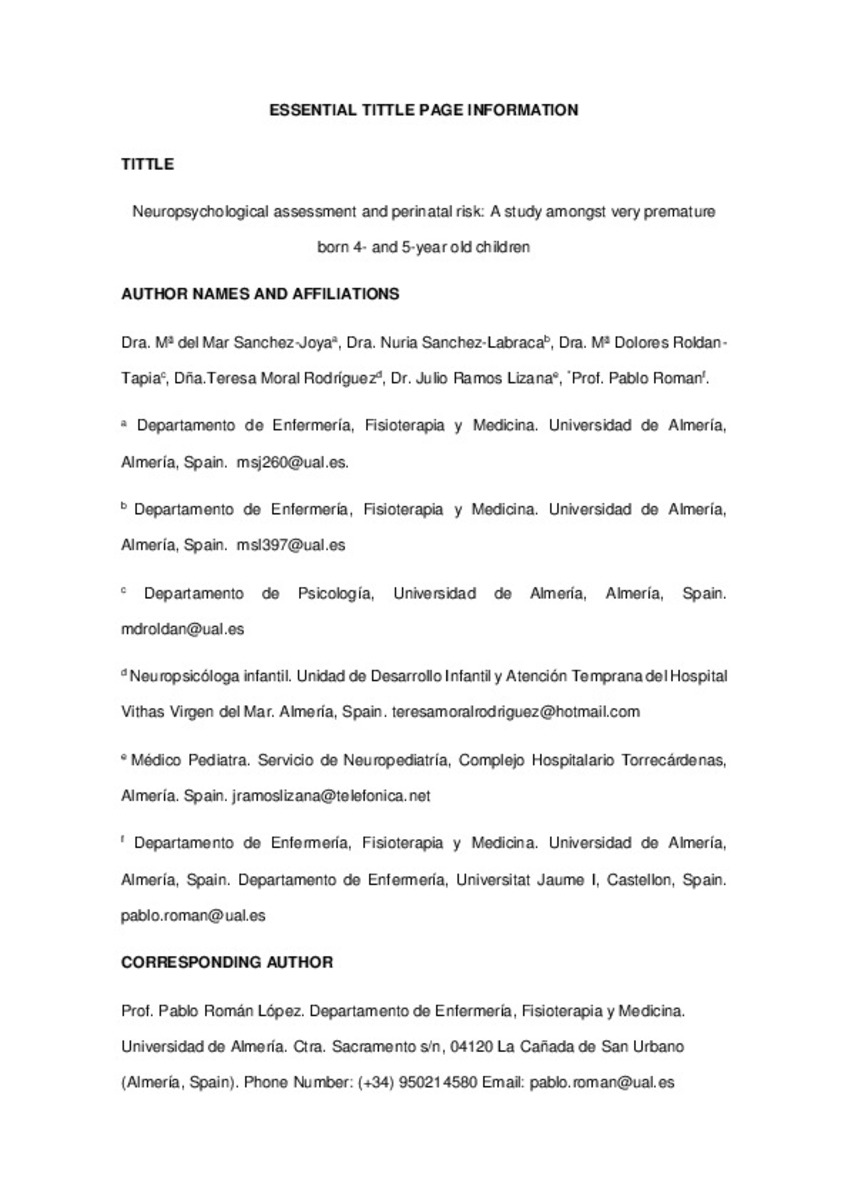Mostra el registre parcial de l'element
Neuropsychological assessment and perinatal risk: A study amongst very premature born 4- and 5-year old children
| dc.contributor.author | Sánchez Joya, María del Mar | |
| dc.contributor.author | Sánchez Labraca, María Nuria | |
| dc.contributor.author | Roldan-Tapia, Maria | |
| dc.contributor.author | Moral Rodríguez, Teresa | |
| dc.contributor.author | Ramos Lizana, Julio | |
| dc.contributor.author | Roman, Pablo | |
| dc.date.accessioned | 2018-01-12T16:54:51Z | |
| dc.date.available | 2018-01-12T16:54:51Z | |
| dc.date.issued | 2017 | |
| dc.identifier.citation | Sanchez-Joya Mª del Mar, Sanchez-Labraca, N., Roldan-Tapia, M. D., Moral Rodríguez, T., Ramos Lizana, J., & Roman, P. (2017). Neuropsychological assessment and perinatal risk: A study amongst very premature born 4-and 5-year old children. Research in developmental disabilities, 69, 116-123. | ca_CA |
| dc.identifier.issn | 0891-4222 | |
| dc.identifier.issn | 1873-3379 | |
| dc.identifier.uri | http://hdl.handle.net/10234/171823 | |
| dc.description.abstract | Background: Prematurity and its consequences are serious problems that can result in numerous neurosensory disabilities and cerebral cognitive dysfunctions. The Perinatal Risk Index (PERI) might provide a predictive measure of these problems. Aim: This study compared the cognitive development of prematurely born children at 4 and 5 years of age with age-matched peers born at term. The secondary objective was to determine whether a correlation exists between perinatal risk and performance on neuropsychological tests among premature children. Methods: A total of 54 children between four and five years of age were evaluated; 27 were born very premature (premature group; PG), and 27 were born at term (term group; TG). Executive function, attention, memory, language, visual perception, and spatial structuring were evaluated. Subtests from the Kaufman Assessment Battery for Children, the Rey Complex Figure Test, the McCarthy Scales of Children’s Abilities, the Peabody Picture Vocabulary Test, Test A, Trails A and B, the spatial structuring questionnaire from the Child Neuropsychological Maturity Questionnaire, and the Wechsler Intelligence Scale for Children were used. A PERI score was also obtained for the PG. Results: The PG showed significantly lower scores than the TG in all the studied cognitive domains. Visual-perceptive scores were significantly and negatively correlated with the PERI scores of the PG. Conclusions: The PG showed neurocognitive deficits compared with the TG. The PERI can be used to predict the development of visual-perceptive abilities in children between four and five years of age. | ca_CA |
| dc.format.extent | 19 p. | ca_CA |
| dc.format.mimetype | application/pdf | ca_CA |
| dc.language.iso | eng | ca_CA |
| dc.publisher | Elsevier | ca_CA |
| dc.relation.isPartOf | Research in developmental disabilities, 2017, vol. 69, p. 116-123. | ca_CA |
| dc.rights.uri | http://rightsstatements.org/vocab/CNE/1.0/ | * |
| dc.subject | prematurity | ca_CA |
| dc.subject | neuropsychology | ca_CA |
| dc.subject | visual perceptive abilities | ca_CA |
| dc.subject | perinatal risk | ca_CA |
| dc.title | Neuropsychological assessment and perinatal risk: A study amongst very premature born 4- and 5-year old children | ca_CA |
| dc.type | info:eu-repo/semantics/article | ca_CA |
| dc.identifier.doi | https://doi.org/10.1016/j.ridd.2017.08.008 | |
| dc.identifier.doi | https://doi.org/10.1016/j.ridd.2017.08.008 | |
| dc.relation.projectID | This work was supported by Ministerio de Economía y Competitividad from Spanish Government (grant number PSI2015-67442-P). PR was supported by a research grant from the Research Plan of the University of Almeria. | ca_CA |
| dc.rights.accessRights | info:eu-repo/semantics/openAccess | ca_CA |
| dc.relation.publisherVersion | https://www.sciencedirect.com/science/article/pii/S089142221730210X | ca_CA |
| dc.type.version | info:eu-repo/semantics/submittedVersion | ca_CA |
Fitxers en aquest element
Aquest element apareix en la col·lecció o col·leccions següent(s)
-
INF_Articles [274]
Articles de publicacions periòdiques







